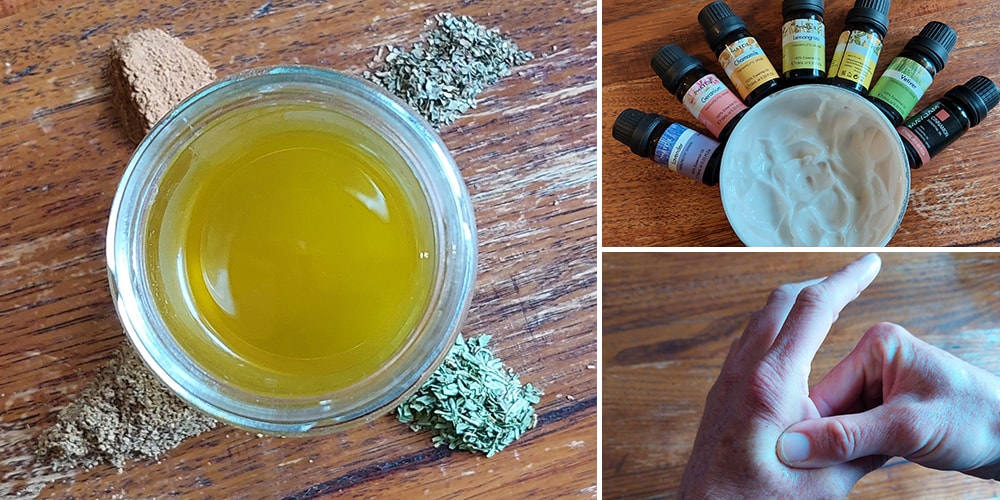
The Anxiety-Relieving Oil
There are plenty of ways to treat anxiety, but when it comes to using an oil-based remedy, there are three options: aromatherapy, oral ingestion, and topical application. Each one has pros and cons, which are explored further below.
The other question is whether to use essential oils (EOs) or make your own infused oils. EOs are more intense in smell, flavor, and effectiveness and only require diluting. Infusing your own oil requires soaking the dried plant material in warm oil for at least 3 hours in a double boiler.
First, let’s look at the pros and cons of using aromatherapy to treat anxiety.
Aromatherapy
Pros
Aromatherapy is simple and safe to use.
Use 2 – 4 drops of EO in a small diffuser for an intense aroma or infuse your own oils for a softer smell. Of course, dried rose petals infused in oil won’t have the same aroma or effectiveness as rose EO, but it’s a nice DIY approach.
Suitable aromatherapy EOs (or infused oils for treating anxiety include lavender, vetiver, rose, clary sage, geranium, cinnamon, sweet basil, and bergamot.
Aromatherapy complements other forms of therapy, for example, yoga and meditation.
Cons
Some EOs used against anxiety have strong scents, such as vetiver.
EOs aren’t always ethically or sustainably harvested.
Homemade infused oils won’t have the same aroma or intensity compared to EOs.
In some situations, oral ingestion of EOs or infused oil is considered more effective than aromatherapy, but there are still some pros and cons.
Ingestion
Pros
Food grade EOs suitable for ingestion include lavender, cinnamon, clary sage, coriander, cilantro, sweet basil, bergamot, lemon grass and ylang ylang. All of these EOs contain high amounts of linalool and/or linalyl acetate which are thought to be the active ingredients for treating anxiety. Dilute 1 – 3 drops of EO with a teaspoon of either pure glycerin, honey or a carrier oil. Take once a day.
Unlike many EOs, homemade infused oils are safe to eat and great to cook with. You can infuse dried lavender, cinnamon leaf or bark, clary sage, coriander seeds, cilantro, sweet basil and ylang ylang flowers in oil to make an aromatic and tasty treatment for anxiety. Use your infusion as a daily cooking or baking oil.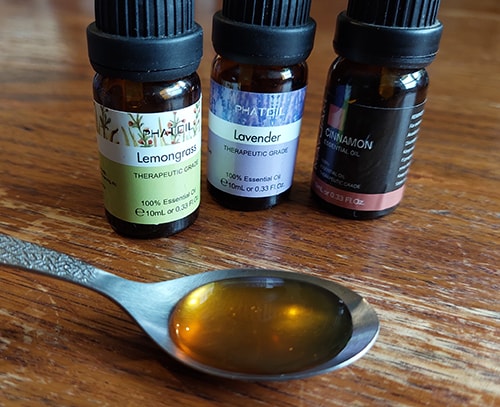
Cons
Only a small number of essential oils are safe to consume, and you should always dilute them with either pure glycerin, honey or a carrier oil and ensure they are food grade.
Making your own infused oil to treat anxiety has limitations due to which dried plant material can be used and the decreased concentration compared to using EO.
When it comes to treating anxiety topically, this usually involves massage with oils. Applying EOs or infused oils to your skin combines aromatherapy with massage therapy.
⇒ Better Than Sleeping Pills (Video)
Topical Use
Pros
Oil massage can reduce anxiety and relieve stress and tension, especially when combined with the acupressure points between your thumb and pointer finger (LI4 point) and just above your inner wrist (P6 point). Other acupressure points that may relieve stress include between your eyebrows, temples, ears, the tops of your feet and between your neck and shoulder. Mix 1 – 3 drops of EO with a teaspoon of carrier oil to massage directly onto the acupressure points. Otherwise use your undiluted infused oil straight on the skin.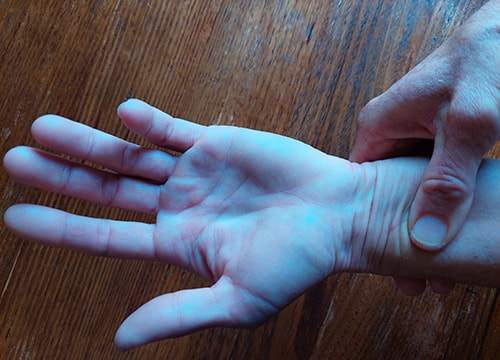
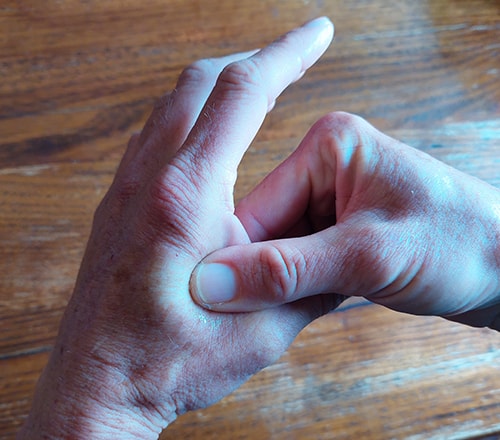
Suitable plants and EOs include lavender, cinnamon, clary sage, coriander, cilantro, sweet basil, bergamot, lemon grass and ylang ylang.
Add 1 drop of your chosen EO to a teaspoon of your daily moisturizer.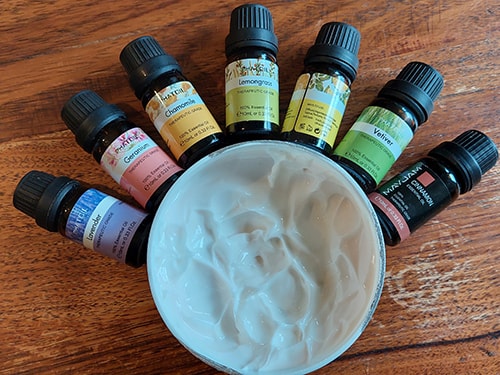
Essential oils can be mixed into shampoo, shower gel and even bubble bath soap, but preferably at the time of application or mixed in small quantities (3 doses at a time). A 1 – 2% dilution rate equates to 5 – 10 drops of EO in ½ oz (14 g) of shampoo.
If you are sensitive to essential oils, then try infusing your own dried plant material into a warm carrier oil for 2 – 3 hours via a double boiler system.
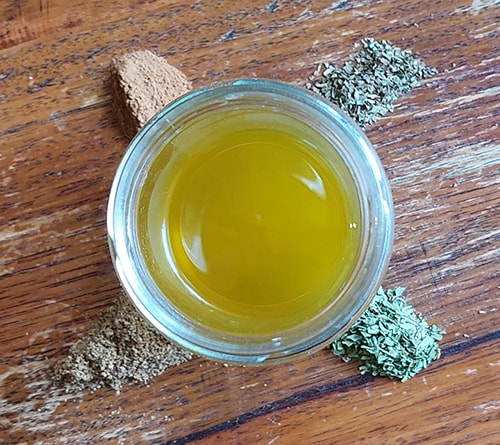
Cons
All essential oils must be diluted with a carrier oil, moisturizer or shampoo to make them safe to put on your skin. For daily usage, it is recommended to dilute essential oils down to 1 – 2%, and the maximum is 5% for occasional use.
Even when diluted to 1%, some people may have an allergic reaction to topical use of essential oils. Test your diluted EO on your forearm first.
Summary of Methods
- Use 2 – 4 drops of EO in a small oil diffuser for 30 minutes each day for aromatherapy.
- Dilute 1 – 3 drops of food grade EO with a teaspoon of either pure glycerin, honey or carrier oil and consume once a day.
- Mix 1 – 3 drops of EO with a teaspoon of carrier oil to massage directly onto the acupressure points. Otherwise use your undiluted infused oil straight on the skin.
- Add 1 drop of your chosen EO to a teaspoon of your daily moisturizer.
- Mix 5 – 10 drops of EO in ½ oz (14 g) of shampoo.
- Infuse dried plant material into a warm carrier oil for 2 – 3 hours via a double boiler system to use in aromatherapy, consumption or topical application.
Other Remedies for Treating Anxiety
The oil-based remedies above only target oil-soluble compounds, such as linalool and other terpenoids. This is why I focused on either EOs or making your own infused oils from plants which contain high amounts of these oil soluble compounds.
However, some plants can treat anxiety via water or alcohol soluble compounds. Therefore, I would also recommend making a cup of tea or a vinegar tincture from the following plants: Valerian root, Tilia flowers, Chamomile flowers and/or St John’s wort.
The Bottom Line
Whether you sit quietly in a room next to an oil diffuser for half an hour, try an oil massage, take a bubble bath or add a few drops of essential oil to your morning smoothie, you should experiment with what works best for you to help manage your anxiety.

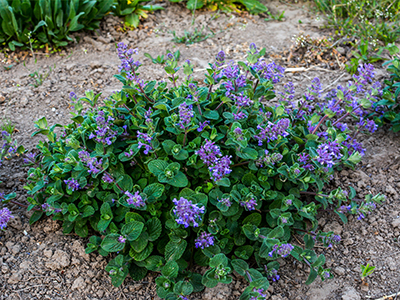
What are the oils to use fir reducing anxiety? Mevet mentioned.
Suitable plants and EOs include lavender, cinnamon, clary sage, coriander, cilantro, sweet basil, bergamot, lemon grass and ylang ylang.
Thank you for this! Is there an essential oil company that you would suggest for oral use?
Young Living, I wouldn’t use any of cheep stuff, pure and the best
DoTerra or YoungLiving.
I order all of my oils from mountain rose to make my products for my line Chloris they have the best true to smell oils I’ve ever experienced!
How long do infused oils keep? And what is the best way to store them?
Hi Bethan,
If stored properly, which means keeping it out of direct sunlight and at a cool temperature, infused oil can survive up to a year. In airtight glass jars or bottles, it can keep for 2-4 weeks at room temperature and up to a year in the refrigerator.
Many blessings and good health!
I would use care in saying its ok to ingest cinnamon, bergamot, or any of the citrus plants as they are highly toxic to your liver!
Lavender EO can be applied without mixing with a carrier. There are others, but that is one of the first ones I learned about being safe used “neat”. I use geranium directly on cold sores and haven’t had any bad reactions except that it tastes bad if it leaks into your mouth. But it dries up the sores within one day.